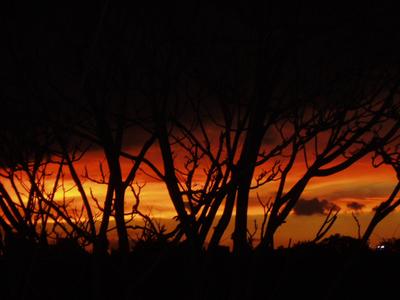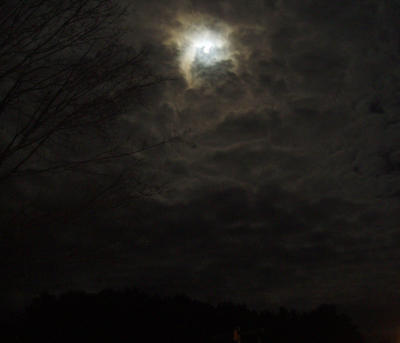Clouds can be nice, too
I saw the sun today after 9 days of clouds, fog and rain here in New York. I can remember longer cloudy periods, but none so intense.

Those were clouds during a sunset in Greenpoint last October. The brilliant red, they tell me, is due to New York's smog.

This was the same scene, more or less, later that month on Thanksgiving morning. Within twenty minutes almost all the clouds had gone.

And this was the full moon the evening of the next day, as seen from Great Barrington, MA. I caught it when it was due East, which tells me that the photo was taken at 7:59 pm, though I have no other way of knowing.
This happened to be the first time I ever saw Titan, the big moon of Saturn. My father-in-law got out his birdscope (magnification of 75x), and the whole family got to see Saturn's rings. It was a terrific evening all around.
Great Barrington was the place where I took a 10-day solitary retreat, shortly before my wedding last year. I was new to astronomy and completely in love with it; I hardly did anything else that week. I wrote 100 pages in my journal about very basic topics, like why and how the sun comes up in a different place every day. I had only brief access to the internet, and I hardly knew any astronomy sites, so I was trying to figure out for myself things that these days I just look up, like the nightly position and identities of Jupiter's moons. I had a birdscope but no telescope, and for much of the time I had no globe of the earth. It was a great experience trying to understand the universe with one's wits and a few instruments. It really gave me a sense of how far our species has come, and how much work was involved -- not to mention mistakes -- in coming to know what we know now.
I got religious about studying the moon's waxing face that week, and clouds were a big deal for me every time they appeared. Two days passed without a glimpse of the moon or anything else, and then this excerpt from my journal:
Great Barrington
June 1, 2004
9:52 pm
In the murky, turbulent, dark clouds I caught patches of strong white light about 20 minutes ago, and I knew the moon was there, well behind its transit of two days ago -- no more than 35 degrees above the SE horizon this time, and nearly turned sideways from my angle. Very eerie scene. At first nothing but white light shone through, and then it would be covered again by clouds, which rolled in all 4 directions and kept opening and closing. Then the moon began shining through, with dark clouds abating but thin and black wisps, or cloudy mists, gliding quickly over the disk.
In my 8x21's I could see the point where Mare Frigoris "spills" its western flank into the Ocean Procellarum, which is now fully visible. To the sea's left, just S of the equator, I could see Grimaldi (crater or sea?), near the western edge of the disk. In the bird scope I could see more, and for a brief moment the clouds revealed a disk so bright that my eye hurt; and many craters, moreover, became hard to distinguish. When the moon is that bright, craters with rays are the most apparent -- Tycho especially. I thought I caught a faintly outlined Longomontanus, while Clavius looks like it's out of view for now, though I can't be certain (and the disk's edge is shimmering as thin clouds pass over). I could also see two craters to the W of Grimaldi (adjacent to it) that are both on my map, though unnamed; on my map there is but a thin sliver not yet revealed.
It's covered now; and nothing else is visible. Not cold tonight at all, and the country is peaceful.

Those were clouds during a sunset in Greenpoint last October. The brilliant red, they tell me, is due to New York's smog.

This was the same scene, more or less, later that month on Thanksgiving morning. Within twenty minutes almost all the clouds had gone.

And this was the full moon the evening of the next day, as seen from Great Barrington, MA. I caught it when it was due East, which tells me that the photo was taken at 7:59 pm, though I have no other way of knowing.
This happened to be the first time I ever saw Titan, the big moon of Saturn. My father-in-law got out his birdscope (magnification of 75x), and the whole family got to see Saturn's rings. It was a terrific evening all around.
Great Barrington was the place where I took a 10-day solitary retreat, shortly before my wedding last year. I was new to astronomy and completely in love with it; I hardly did anything else that week. I wrote 100 pages in my journal about very basic topics, like why and how the sun comes up in a different place every day. I had only brief access to the internet, and I hardly knew any astronomy sites, so I was trying to figure out for myself things that these days I just look up, like the nightly position and identities of Jupiter's moons. I had a birdscope but no telescope, and for much of the time I had no globe of the earth. It was a great experience trying to understand the universe with one's wits and a few instruments. It really gave me a sense of how far our species has come, and how much work was involved -- not to mention mistakes -- in coming to know what we know now.
I got religious about studying the moon's waxing face that week, and clouds were a big deal for me every time they appeared. Two days passed without a glimpse of the moon or anything else, and then this excerpt from my journal:
Great Barrington
June 1, 2004
9:52 pm
In the murky, turbulent, dark clouds I caught patches of strong white light about 20 minutes ago, and I knew the moon was there, well behind its transit of two days ago -- no more than 35 degrees above the SE horizon this time, and nearly turned sideways from my angle. Very eerie scene. At first nothing but white light shone through, and then it would be covered again by clouds, which rolled in all 4 directions and kept opening and closing. Then the moon began shining through, with dark clouds abating but thin and black wisps, or cloudy mists, gliding quickly over the disk.
In my 8x21's I could see the point where Mare Frigoris "spills" its western flank into the Ocean Procellarum, which is now fully visible. To the sea's left, just S of the equator, I could see Grimaldi (crater or sea?), near the western edge of the disk. In the bird scope I could see more, and for a brief moment the clouds revealed a disk so bright that my eye hurt; and many craters, moreover, became hard to distinguish. When the moon is that bright, craters with rays are the most apparent -- Tycho especially. I thought I caught a faintly outlined Longomontanus, while Clavius looks like it's out of view for now, though I can't be certain (and the disk's edge is shimmering as thin clouds pass over). I could also see two craters to the W of Grimaldi (adjacent to it) that are both on my map, though unnamed; on my map there is but a thin sliver not yet revealed.
It's covered now; and nothing else is visible. Not cold tonight at all, and the country is peaceful.
Comments